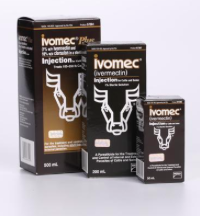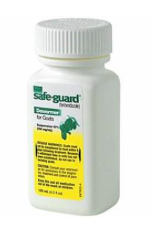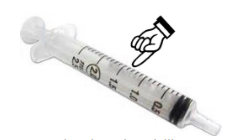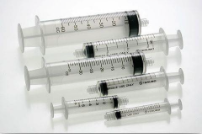Pigs can and do get parasites, including worms. Ivermectin is used to treat mange mites (scabies), lice, roundworms, lungworms, threadworms in swine. Fenbendazole treats tapeworms, whipworms, roundworms and hookworms. Swine performance is influenced by internal parasites, most dramatically in the young, growing pig. Parasites reside in the stomach and intestinal tract of the pig, causing irritation, impaction, indigestion and lack of appetite. Parasites cause loss of nutrients from feed consumed by competing with the host, and by causing poor digestion, gut ulceration and even blood loss. Even small numbers of the large roundworm Ascaris suum can depress feed intake and daily gain and cause a depression in gain:feed ratio. Some worm parasites may be found in the lungs, where they interfere with respiration. This in turn may result in pneumonia. Below is Cathy Zolicani’s (DVM), dosing recommendations for these preventive medications. Ask your vet how often they’d like your pig treated or establish a regular “dewormimg” regimen. Pigs should be dewormed on a regular basis for internal and external parasites (usually every 4-6 months). Some vets may have you treat more than Cathy recommends based on your particular circumstances. Each medication has separate doses and their own time frame in which they need to be given in order to be effective and treat the parasite efficiently. Both of these medications are safe and effective, both can be used in pregnant pigs, but not recommended in piglets under 6 weeks of age. When a pig is infected with parasites, they have the potential for not growing properly, their nutrition isn’t adequate because they have a parasite not allowing the essential vitamins and minerals to be absorbed as they would in a pig without parasites. Often times, pigs that have an infestation of worms, will have a bloated belly and won’t be able to gain a lot of weight. Malnutrition can be a serious issue if this isn’t addressed. These parasites are common in the pigs environment, especially those that root and graze or spend time outdoors. They can contract parasites from soil, grazing, other pets, other pigs, eating bugs (including earth worms or mealworms), contact with hay, even if pig parents have horses, work in a barn or come into contact with other species that can host these parasites, they could possibly bring parasites to their indoor pigs. Most of these parasites will show no symptoms until after they have taken a toll on your pig’s health. Many of the parasites will not show up on a fecal exam especially if they have invaded organ systems as some do. If a pig has mange, they tend to turn an orange color (not to be confused with pig rust, which is often found on “pink” pigs and will be discussed in another area on the website) and constantly scratch on anything they can get close enough to rub against often leaving scrapes and raw areas all over their body. These are classic signs of worms and mange, every pig is different and will present with different clinical signs, please see examples below.
Symptoms may include the following:
Coughing
Loss of body condition or poor growth
Hairy pigs
Vomiting
Blood in feces but rarely
Anemia
Diarrhea
Bloated or distended belly
Possible types of worms based on symptoms:
Coughing – consider lungworm but only if the environment could give access to earth worms or beetles. Ascarid larvae as they migrate through the lungs can increase the incidence of pneumonia and coughing.
Wasting – round worms, coccidia, kidney worms or Balantidium coli.
Blood in the urine-kidney worms.
Blood in the feces-coccidiosis, trichuris infection.
Anemic pigs – stomach worms
TREATMENT
Dosing instructions by Cathy Zolicani, DVM
Ivermectin – for treatment of mites, lice and a variety of internal parasites, but DOES NOT treat tapeworms.
Use 1% injectable form for horses, cows, or swine (brand name Ivomec or Noromectin) –Treats, mites, lice, and a variety of internal parasites. (but not tapeworms) Also good for mites and lice that your pig may get while grazing or contact with other pigs. Do NOT use paste wormers, they are too difficult to accurately dose. This medication should be used in combination with fenbendazole to ensure ALL parasites are eliminated.
With a small syringe, dose 0.2 cc or ml per 10 pounds of body weight to mix with pig’s food. Your pig will need 2 doses, 14 days apart. Repeat these 2 doses every 4-6 months if your pig grazes, lives outdoors or is exposed to other pigs. This bottle will cost between $40-50 dollars, but will last years in a normal pet pig household. Make sure you check the expiration date on purchase and make a note of when it expires. Typically this is 2 years after purchase.
The injectible formula tastes bitter given orally so mix with food to cover the taste. This will ensure a stress free deworming, the pigs think they’re getting a special treat. Mix with yogurt, canned pumpkin, apple sauce or squirt into a piece of bread, Oreo cookie, into a strawberry, grape or spongy type food that can absorb the liquid. This medication can be used in pregnant pigs, but its not recommended for piglets under 6 weeks old.
Fenbendazole – for tapeworms,whipworms, ascarids. DOES NOT treatmites or lice.
Use safeguard for goats, 10% suspension (100 mg/ml) (brand name Safe-guard)– for tapeworms, whipworms, ascarids but does not treat mites or lice. Therefore, this is an excellent addition to Ivermectin but should not replace it. Dosing with this oral suspension is easy. This should be used in combination with Ivermectin to ensure ALL parasites are eliminated.
Mix 0.1 ml or cc per 10 lbs of body weight, mixed into food such as canned pumpkin or yogurt. This dose should be given once a day for three days in a row. If worms are suspected, repeat the 3 day dosing two weeks after the first dosing. Regular schedule for Fenbendazole is every 4-6 months. This medication can be used in pregnant pigs but it’s not recommended for piglets under 6 weeks.
**If your pig has never been “dewormed”, the pig is new to the household or its been more than 6 months since the last treatment, you can give the Ivermectin as instructed above or take a stool sample to the vet for testing. Remember, not all worms are detectable in the feces, so although the fecal test may be negative, your pig can still have parasites/worms. If your pig is super itchy or has the mangey orangish/red color skin (that doesn’t wash off), odds are your pig has sarcoptic mange and needs to be treated. Your vet can take a skin scraping and test for the prescense of these parasites, or you can treat proactively. Mites are not insects, instead, they’re more closely related to spiders and are microscopic, so you can’t see them with the naked eye. The female burrows in the skin leaving a trail of eggs behind her. these eggs hatch in 3-10 days and the cycle repeats itself over and over again. Mites prefer hairless skin and thus the ear flaps, elbows and abdomen are at highest risk for the red, scaly itchy skin that characterizes sarcoptic mange. It also be misdiagnosed and lead you down the wrong path assuming there is an allergy due to the body’s natural response to an allergen. It can be passed along to humans in the form of scabies, but it tends not to persist on these hosts. They usually go away on their own in humans because we do not make an ideal host for them to complete their life cycle, however, they are extremely itchy if/when they are present. Your primary care doctor can prescribe a cream to help with the eradication of the mites on you faster. (Just be sure to tell your family doctor that you have a pig who has or possibly has mange)
If you’d like to read more on potential worms, here’s a link regarding the different types of common worms in swine.
http://www.morrisvetcenter.com/morrisvet/Livestock/Swine-parasites.asp
http://extension.missouri.edu/p/G2430
Both dewormers can be found over the counter at local feed stores, Tractor supply, or online at Amazon, Jeffers, KV Vet Supply, etc. Both dewormers can be given orally (no need for stressful injections) at home.
Although rare, you can overdose your pig using these medications. When Ivermectin is given in high enough doses, it can cross the blood-brain barrier and cause neurologic signs in dogs, including weakness or paralysis of one or more limbs, balance disorders, vision disorders, pain, and seizures. Ivermectin toxicity can occur whether the drug is given orally, topically (applied to the skin) or parenterally (by IV or injection).
There are very few overdose warnings for the Fenbendazole, it is overall a safe medication.
Source for Ivermectin warning: http://healthypets.mercola.com/ivermectinwarning
Common Questions regarding parasite control
Where do I buy dewormers?
Ivomec and Safeguard- Tractor Supply stores, local feed stores or Amazon.com
Are there ways to tell that your pig has worms or needs to be “dewormed”?
Yes, your vet can use a fecal sample and test it for the presence of some worms, however, these tests aren’t 100% accurate and don’t always detect the parasites. Some parasites migrate from the colon and invade organs and other tissues and won’t be seen on a traditional fecal test. Some pigs will have a distended or bloated looking belly, you may see worms in the feces, some pigs eat and eat but don’t gain weight. These are just a few of the signs that may point to a pig needing to be treated for a possible parasite infestation.
Can I use natural wormers like pumpkin seeds?
You can use anything piggy approved, however, these two medications combined are known to be effective in eradicating the internal and external parasites. Using a home remedy or something not proven to be effective can lead to health complications or generalized discomfort of your pig and not necessarily eliminating the parasites.
What age do I start deworming?
6 weeks old is a great time. If piglet is younger than 6 weeks please consult a veterinarian. Anytime after 6 weeks, you want to treat the pig as soon as she arrives home, even if you were told she has already been dewormed. Remember, you will treat as directed above, it will need to be done twice within 10-14 days for the Ivermectin and every 3 days, then that cycle repeated for the Fenbendazole.
Can pigs get fleas?
In most cases, the fleas on pigs are really not an issue. Fleas live for 180 days, only about 20 on a host. The rest of the time they are in the environment (your rug) making flea woopie. So dusting your carpets, letting it sit for 48 hr and then vacuuming will greatly reduce your problem. It’s messy but effective.
How often should I deworm?
Most pigs are just fine with a twice a year schedule. Every 6 months. Spring and Fall. In especially warm climates or areas with heavy parasite loads, you may choose to treat every 4 months year round, with both ivermectin and fenbendazole.
Do I have to give my pig a shot?!
No, and its not recommended to give by injection. Some of these meds are bitter, so you won’t want to squirt directly into the mouth. You can inject the medication into something your pig will enjoy eating like a cupcake or other spongy food that is able to absorb the liquid.
How do I know if my pig had worms?
You can possibly see worms in the feces a few days after your pig has been given the medication to eradicate them, but you may not see or notice all types. Treating proactively helps reduce infestations that you may not be able to see.
Do inside pigs need to be dewormed?
Yes. Pigs that live indoors typically have access to the soil where some of these parasites reside. It’s best to start and maintain a regular deworming schedule.
An article on mites and deworming http://potbelliedpigs4ever.com/worming
How do I calculate the dose? I have never used a syringe!!
Recently, I have had several people to ask me to help them with determining the dose for their pig and while I don’t mind doing this, I thought it would be helpful to do a calculation here and show you how to read the syringe so that you can be sure you’re doing it correctly.
If you have a 70lb pig and you are dosing for Ivermectin, you will divide the 70 lbs by 10 (because the dose is 0.2cc for every 10 lbs). that leaves you with 7. Multiply 7 x 0.2 (because you want to give 0.2cc of the med for every 10 lbs) and that gives you the amount you need to give, in this case, 1.4cc or 1.4ml.
This is 1.4ml or cc on a 2.5ml syringe to draw the medication up into the syringe, inject into something yummy (it has a bitter taste if squirted directly into the mouth, so its recommended that you inject into something spongy like a cupcake), then give the ivermectined treat. Repeat in 14 days. You will use a needle and syringe that breaks the ml into the easiest numbering system for you to calculate an accurate dose, in this case, a 2.5ml syringe was appropriate. For smaller pigs, you may need to use a 1cc syringe to give an accurate dose, for bigger pigs, you may need a 5cc syringe in order to give an accurate dose. Use what is easiest for you. If you have questions or need help calculating the dose for your pig, please reach out to us, we are always happy to help!
You will use a needle and syringe to draw the medication up into the syringe (example to the right), inject into something yummy (it has a bitter taste if squirted directly into the mouth, so its recommended that you inject into something spongy like a cupcake), then give the ivermectined treat. Repeat in 14 days.
These are all common syringes, as you can see, they come in many different sizes. Typically a 2.5cc or 5cc syringe is what you will need. Smaller pigs may need a more precise syringe like a 1cc syringe so the dose will be super accurate. These syringes are usually less than a dollar at feed stores, so you can buy a couple of different sizes to suit your needs. Don’t ever hesitate to ask someone else for help, not everyone has a medical background and knows how to read a syringe. Again, in each syringe, the lines in between the big numbers represent something different. In a 3ml syringe, each line typically represents 0.2ml, but in the 2.5cc syringe pictured above, each line represented 0.1ml. So, you have to determine what each line represents before drawing up the medication into the syringe. Let me add, cc and ml are the same and used interchangeably.
Sources:
http://www.thepigsite.com
http://www.merckmanuals.com
http://vetmed.iastate.ed
http://www.morrisvetcenter.com
http://www.merckmanuals.com/vet
http://www.merckvetmanual.com/parasites_of_pigs/strongyloides
http://www.vetnext.com
http://vetmed.iastate.edu/vdpam
http://vetmed.iastate.edu/vdpam/swine-diseases/kidney-worm-infectio



